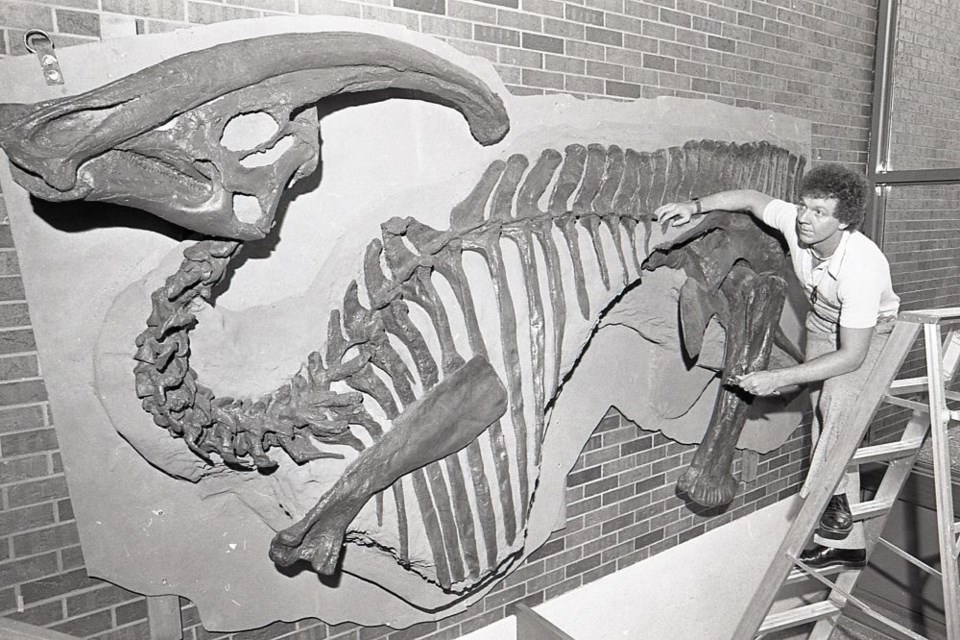From the archives of the Sault Ste. Marie Public Library:
A dinosaur… in the library? Yes! A Parasaurolophus [Para-sore-oh-loaf-us] to be exact.
Between October 30, 1978, and March 5, 1979, Lophy the Parasaurolophus skeleton had a home at the Sault Ste. Marie Public Library on East Street. Lophy, affectionately named by library staff, came to the Centennial Library by way of the Royal Ontario Museum’s Extension Services, in co-operation with Outreach Ontario, a Program of the Ministry of Culture and Recreation.
Lophy was a 10.5-foot high and 12.5-foot wide life-size reproduction. Made out of naturally coloured fibreglass, the bones were positioned exactly as the real specimen was found in Dinosaur Provincial Park, Alberta by a team from the Royal Ontario Museum, in 1920.
According to the Royal Ontario Museum (ROM), in 1978, there were only four surviving Parasaurolophus skeletons in the world, with the ROM’s being the most complete.
Without a doubt, the Parasaurolophus skeleton was and still is the ROM’s most famous dinosaur exhibit. In response to the great interest in the Parasaurolophus, the ROM’s Vertebrate Paleontology Department created a cast of the dinosaur for Extension Services, creating one very unique travelling exhibit.
The Parasaurolophus was a duck-billed dinosaur that inhabited the land formation we now call Western North America during the late Cretaceous period, approximately 70 million years ago.
The Parasaurolophus belonged to the reptilian order of Ornithischia and the family of Hadrosauridae. Paleontologists have concluded that this dinosaur had the blunt teeth of a herbivore (plant-eater) and most likely walked on all four legs a majority of the time, although it could probably run quickly on its strong hind legs.
It had a duck-like beak, adapted for plucking leaves and twigs. The large head crest projecting from its skull was an extension of the nose and upper jaw. The air passage from the throat to the nostrils looped up inside the crest.
Scientists believe that this chamber inside the crest improved the dinosaur’s sense of smell and was used for calling to one another. The Parasaurolophus was approximately 25 to 30 feet (8 to 9 meters) in length.
While at the Sault Ste. Marie Public Library, the exhibit attracted over 10,000 visitors. School classes made special trips to see Lophy inside the lobby.
The travelling exhibit also included two text panels and a 12-minute audio-visual presentation featuring Parasaurolophus and vertebrate paleontology. One of the panels featured a small-scale restoration of the dinosaur in its habitat, a scientist’s conception of Alberta as it was 70 million years ago! In addition to the free mini-posters displayed at the Centennial Library, small souvenirs could be purchased at the Historical Society in the Armories on Pine St.
On March 5, 1979, Lophy left the Sault Ste. Marie Public Library and made his way to Thunder Bay, Ontario.
Check out this Royal Ontario Museum link to see a real Parasaurolophus skeleton and other vertebrate fossils.
If you plan on making your way to Toronto, you may want to visit the Royal Ontario Museum’s Dinosaur Gallery. The gallery website can be found by clicking this link.
Each week, the Sault Ste. Marie Public Library and its Archives provides SooToday readers with a glimpse of the city’s past.
Find out more of what the Public Library has to offer at www.ssmpl.ca and look for more Remember This? columns here
